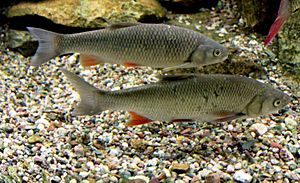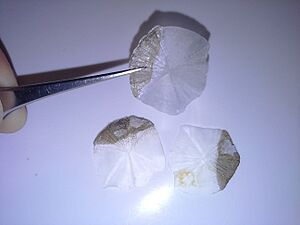European chub facts for kids
Quick facts for kids European chub |
|
|---|---|
 |
|
| Conservation status | |
| Scientific classification | |
| Synonyms | |
|
The common chub (Squalius cephalus), also called the European chub, is a type of freshwater fish. It belongs to the carp family, Cyprinidae. These fish live in rivers, canals, and lakes. They can be found in both slow and fast-moving water.
Contents
About the Chub
The chub is a strong fish with a big, round head. Its body is long and shaped like a cylinder. It has large greenish-brown scales. These scales have thin black edges on the back. They become golden on the sides and much lighter on the belly. The tail is dark brown or black. The fin on its back is greyish-green. All its other fins are orange-red. Chub can grow up to 60 centimeters (about 2 feet) long. However, most chub are around 30 centimeters (about 1 foot) long.
Where Chub Live
Chub are found across most of northern Europe and Asia. You can find them in rivers that flow into many seas. These include the North, Baltic, Black, White, Barents, and Caspian Seas. They also live in rivers in France and Great Britain. Chub are not originally from Ireland or Italy. But they have been brought to these countries and now live there.
Chub's Home and Habits
Chub are most common in small rivers and large streams. They like areas with fast-moving water and calm pools. They also live along the banks of slow-moving rivers. You can find them in big lakes and even mountain streams. Adult chub usually live alone. But young chub like to be in groups called shoals.
Young chub eat many different small animals. These include creatures that live in water and on land. Bigger, older chub mainly eat freshwater shrimp and small fish. In the United Kingdom, chub eat worms, snails, and insects. Large chub also eat many small fish like eels and minnows. They even eat frogs, crayfish, small rodents, and young birds. They have been seen eating berries from trees hanging over the water. Chub will eat all year round if they can find food.
Chub Reproduction and Life Cycle
Chub start to reproduce when the water gets warm, around 14 degrees Celsius (57 degrees Fahrenheit). This usually happens from May to September. They lay their eggs in fast-moving water over gravel. Sometimes they lay eggs among plants underwater. Female chub lay eggs more than once each season. Each female will mate with several males. Males gather at the spawning spots. They follow the females, often splashing a lot. Females lay pale yellow, sticky eggs. These eggs stick to gravel, plants, and stones in the flowing water.
Male chub become ready to reproduce at 2 to 4 years old. Females are ready at 4 to 6 years old. Some fish might mature later. Chub can live for up to 22 years in the wild. Scientists can tell a fish's age by counting the rings on its scales. These rings show how much the fish grew each season.
Threats to Chub
Scientists have found that chub can eat tiny plastic pieces called microplastics. Up to 25% of the fish studied had these particles. However, the plastic was not found in their muscles. Many of these particles are fibers from clothes. These fibers are released when clothes are washed.
Chub can also be affected by metal pollution. Metals like copper, magnesium, and sodium can build up in their bodies. These metals can be found in their muscles, gills, and liver. Young chub often have high levels of these metal pollutants.
Fishing for Chub
Chub are popular with people who like to fish. This is because they are often willing to bite. They can be caught in almost any weather. Small chub are easy to catch, even for new anglers. But as they get bigger, chub become more careful. They can be easily scared by noise or if they see someone. Because of this, catching large chub (over 2 kilograms or 4.4 pounds) is a fun challenge for experienced anglers.
The record for the largest chub caught in Britain was broken in 2012. A fish weighing 9 pounds and 5 ounces (about 4.2 kilograms) was caught. The European record is 5.72 kilograms (about 12.6 pounds). Chub can reach a maximum length of 64–82 centimeters (25-32 inches).
Fishing Gear and Tips
Catching smaller chub is not too hard. For small or medium rivers, you can use a float or a feeder. You can use almost any bait, like maggots, luncheon meat, or sweetcorn. Small lures and flies also work. Chub also eat fishmeal pellets, which are used as fish food.
Catching bigger chub needs patience and quietness. Most large chub are caught in smaller, clearer rivers. So, the angler must be very quiet and not disturb the fish. Many anglers set up their fishing gear before they get to their spot. This makes less noise and won't scare the fish.
A good spot for chub is near branches or bushes hanging in the water. Chub don't like too much sunlight. So, many anglers fish at sunrise or sunset. This is when chub leave their hiding spots. Look for areas where the current pushes food around. This is where feeding fish will likely be. For bigger chub, use larger baits like luncheon meat. Smaller baits might attract tiny fish. For fishing line, a strength of 4-8 pounds is good. New anglers should use stronger line until they learn how to handle the fish.
Feeder or Ledger Fishing
This method often uses a special rod called a quiver-tip rod. It needs at least four-pound line because of the weight of the feeder or ledger. In feeder fishing, bait is put on a hook and inside a feeder. The current carries the bait out, attracting fish to the hook. This usually uses smaller baits like sweetcorn. Ledgering is similar, but it uses a weight (called a ledger) instead of a feeder. Heavier baits like luncheon meat are often used.
Another way is "touch-ledgering." Here, you don't use a quiver-tip rod. Instead, you hold the fishing line that comes off the reel. You feel for any tugs or if the line goes loose. Some anglers do this without weights. They let the bait slowly drift downstream while holding the line. Slugs and luncheon meat work well for this method.
Float Fishing
With float fishing, you can fish right under your rod tip in deep water. Or you can let the float drift gently to where the fish might be. This is called "trotting." While trotting, you throw small amounts of bait into the stream. This encourages the fish to feed. A lighter rod is often used, and sometimes a special reel called a centerpin reel. Anglers must react quickly when trotting, as bites can be easy to miss. Drifting baits like bread, sweetcorn, and maggots are commonly used.
Lure Fishing
This method is usually for catching larger chub. It uses a light spinning rod with a reel that has at least 10-pound line. This is because it's easy to get snagged on things underwater. Small lures, like bar-spoons or soft-plastics, can look like the small fish that big chub eat.
Fly-Fishing
Using flies that look like damselflies or larger, dark flies that imitate slugs can be very effective. This works well if the fly is presented correctly. Shinier flies that look like small fish might work for more aggressive chub. This method can be used all year, but it's best in warmer months. Flies that look like nymphs also work well. In late summer, flies that look like grasshoppers and beetles are also very good.




